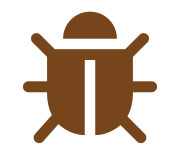WDI stands for wood destroying insect. An inspection for WDIs is commonly needed for the sale of homes. Most of the time, these inspections are not included in a general inspection of the home or always required but can prove beneficial before your new purchase. With a thorough inspection, WDIs and their damage can be […]
Natural Ways to Reduce a Mosquito Population
Mosquitos undergo complete metamorphosis (egg, larva, pupa, adult). Understanding their lifecycle, especially egg laying sites, in NW Indiana is essential to the reduction of populations. Female mosquitos lay eggs in either floodwater areas or an area with a stagnant water source. Floodwater areas are described as low-lying areas that will eventually collect and hold water. […]
Read More… from Natural Ways to Reduce a Mosquito Population
Wasps and Decks
As the spring rains give way to the abundant sunshine and steady heat of mid- summer, wasp activity reaches its peak. Paper wasps build a simple nest consisting of one layer of open cells called “combs.” These nests typically hang suspended from horizontal surfaces that include but may not be limited to window ledges, shutters, […]
Subterranean Termites and Their Castes
There are four types of termites in the United States. Due to the harsh winter conditions, only one can survive in NW Indiana. The subterranean termites live within the soil and feed on cellulose based materials. Essential to the eco system, they become a problem when they start to forage into man made structures. They […]
Ticks
Ticks spend most of their life at or near ground level where they wait on a suitable host for the purpose of securing a blood meal. They will also climb and are commonly found in tall grasses, weeds, bushes, shrubs, firewood, logs, fenceposts and siding. They detect the presence of a vertebrate mammal through vibration, […]
Tiny Troublemakers: Solutions for Small Ant Infestations
While ants may be small, they can become a big nuisance when they invade our homes. These tiny insects are notorious for infiltrating kitchens, pantries, and even bedrooms in search of food and water. While their size may make them seem harmless, the sheer numbers in a colony can quickly turn a minor annoyance into […]
Read More… from Tiny Troublemakers: Solutions for Small Ant Infestations
The Battle of The Bedbugs-Tips and Prevention
Bedbugs are tiny, reddish-brown nocturnal pests, and have become a growing concern for homeowners and travelers alike. These blood sucking insects are notorious for causing discomfort and stress due to their ability to infest homes, hotels, and other dwellings. Throughout this blogpost, we will discuss their biology, signs of an infestation, and steps to prevent […]
Read More… from The Battle of The Bedbugs-Tips and Prevention
Carpenter Bees
In the spring of the year many homeowners begin to notice large furry bees with black and yellow coloring hovering and “bouncing” off of their wooden siding, overhangs and fences. These are female Carpenter Bees that have already mated and are in search of a suitable wooden surface to bore into for the purpose of […]
It’s Small Ant Season!
Of all the insects that are commonly noted in our area, few are more prevalent than the small pavement ant. They are subterranean (their colonies exist below ground) and they are widely dispersed in a variety of soil types throughout the Midwest. In the spring, fall and summer they can easily be seen outside in […]
Don’t let the Bedbugs Bite
“Sleep tight, don’t let the bedbugs bite.” A forgotten phrase that was once common place, now carries new meaning. Almost eliminated in the U.S. due to the widespread use of harsh chemical that are no longer EPA approved, Bedbugs have come back in force. Hopefully you will never have to share a bed with them, […]








